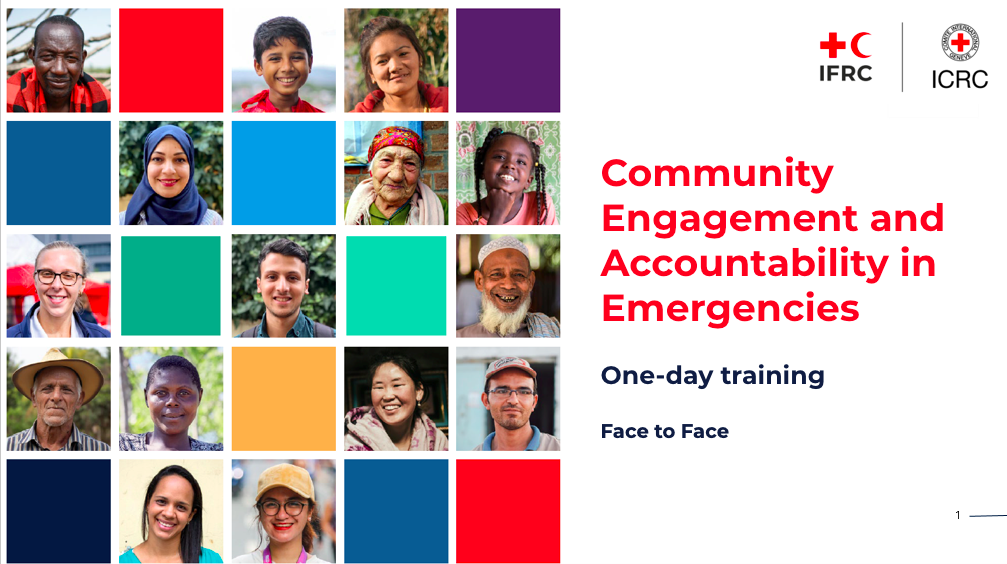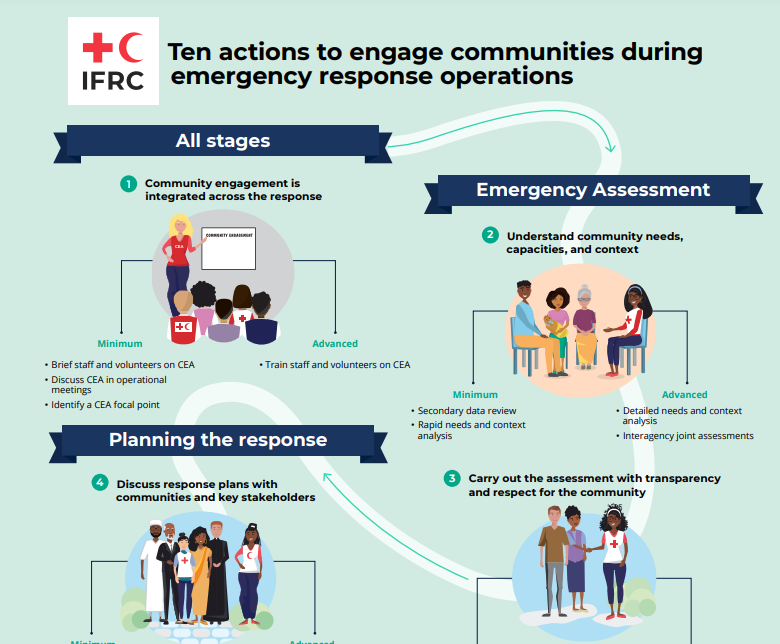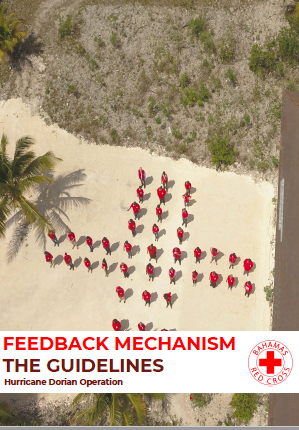CEA in Emergencies
This page is a one-stop shop for CEA in emergencies. It outlines the minimum actions for community engagement at each stage of the response, and the tools to help you put these into practice. It has links to CEA training packs for emergencies, a guide to CEA in emergencies, and case studies specific to conflict, earthquakes, extreme weather, and health.
Ten actions to engage communities during emergency response operations
To successfully engage communities during emergency response operations, CEA should be incorporated into all stages of the programme cycle. To help you to do this, you can follow the ten actions below which have been categorised by the different stages. Under each action, you’ll also find a list of related tools from the CEA Toolkit. View a full explanation of each step here.
All stages of the programme cycle
Emergency assessment
Planning the response
During implementation
Evaluating and learning
Thematic Emergency Pages
Explore CEA in Emergencies Related Trainings
The end goal of community engagement is really about people having the information they need to take action.
It’s about people having a way to feedback to us, to influence the way we deliver an operation…
Explore CEA in Emergency Case Studies
2 July 2019
Beneficiary Communications Review – Haiti 2013
Type:
ReportOrganization:
IFRCA review of the beneficiary communications tools – like SMS and radio – used by the IFRC in the Haiti earthquake response. The review looks at their deployment and effectiveness,…
2 July 2019
Flyer – Relief package for people affected by Nepal earthquake
Type:
PublicationOrganization:
IFRCAn IFRC flyer which provides people with information about the relief package following the Nepal earthquake. It includes information about what the package includes, who it is for and how…
2 July 2019
Frequently asked questions on relief package
Type:
PublicationOrganization:
IFRCThis IFRC document provides guidance and answers to Frequently Asked Questions during the Nepal Earthquake. It can also be adapted to other emergency contexts.
2 July 2019
Flyer – Seasonal support to earthquake affected communities
Type:
PublicationOrganization:
IFRCAn IFRC flyer featuring information on support following the Nepal earthquake, who was eligible, where and when assistance was provided, and other important information for affected communities.
2 July 2019
Flyer – Earthquake seasonal support program
Type:
InfographicOrganization:
IFRCThis flyer forms part of the IFRC’s Earthquake Seasonal Response Program. It provides advice on what people can buy with the cash grants the Red Cross provides to prepare for…
2 July 2019
Engaging with people affected by conflict and violence video (Arabic subtitles)
Type:
VideoOrganization:
ICRCThis Arabic animation produced by the ICRC and the Harvard Humanitarian Initiative illustrates their joint working paper: Community Partnership with People Affected by Armed Conflict and Other Violence.
2 July 2019
SURE programme – video report
Type:
VideoOrganization:
InsightShareA Participatory Video (PV) produced by InsightShare to support the CEA efforts of the British Red Cross and Nepal Red Cross Society, as part of the region’s SURE programme.
2 July 2019
Earthquake recovery programme – video report
Type:
VideoOrganization:
InsightShareA Participatory Video (PV) produced by InsightShare to support the CEA efforts of the British Red Cross and Nepal Red Cross Society, as part of the region’s earthquake recovery programme.
29 June 2019
Good practices, opportunities, methodologies and recommendations for the Incorporation of Cross-cutting Themes in Emergency Preparedness and Response
Type:
ToolOrganization:
Canadian Red CrossA guide produced by the Canadian Red Cross on ‘Good Practices, Opportunities, Methodologies and Recommendations for the Incorporation of Cross-Cutting Themes in Emergency Preparedness and Response’.
29 June 2019
Cash Transfer Programme – Ecuadorian Red Cross
Type:
VideoOrganization:
Ecuadorian Red CrossA video showing a Cash Transfer Programme implemented by the Ecuadorian Red Cross. The programme aimed to provide financial support to families affected by the 2017 earthquake and stimulate the…
27 June 2019
Charting the new norm?
Type:
ReportOrganization:
Humanitarian Advisory GroupA report from the Humanitarian Advisory Group and the Pujiono Centre: ‘Charting the Norm? Local leadership in the first 100 days of the Sulawesi earthquake response’. The report looks at…
20 June 2019
SURE programme – video report
Type:
VideoOrganization:
InsightShareA Participatory Video (PV) produced by InsightShare to support the CEA efforts of the British Red Cross and Nepal Red Cross Society, as part of the region’s SURE programme.
Page 6 of 7
In partnership with:











